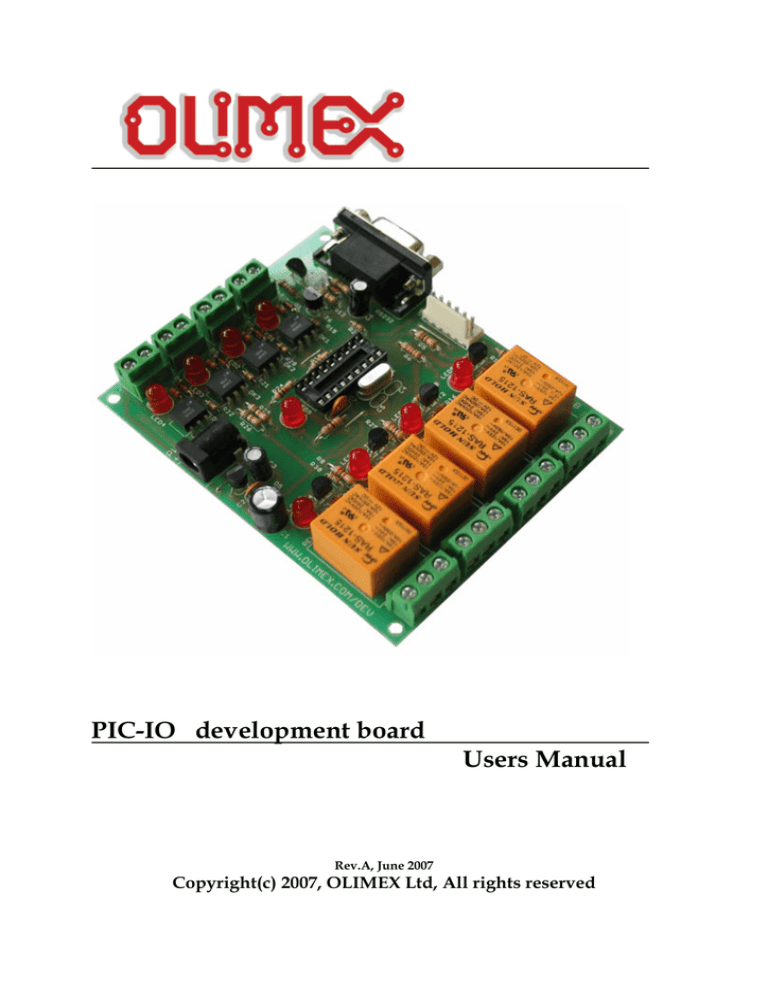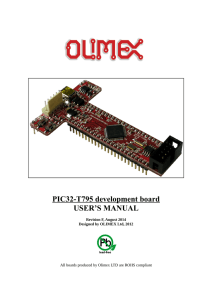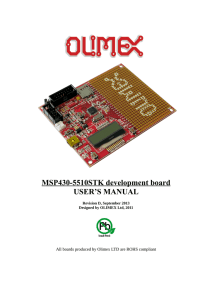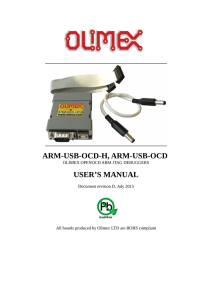
PIC-IO development board
Users Manual
Rev.A, June 2007
Copyright(c) 2007, OLIMEX Ltd, All rights reserved
INTRODUCTION:
PIC-IO board was designed as simple platform which to allow control of
appliances and devices with PIC, the idea was to build something like
tiny PLC controller which is possible to program in C or assembler
instead of the weird PLC relay language.
Let’s see what we have on board:
Four High voltage/ High Current relays – with NO-NC-COM contacts
available on terminal block. The relay switching current is rated:
15A/125VAC, 10A/250VAC, 15A/24VDC. Note that these relays are
good for switching resistive loads, but if you have to commutate
inductive loads the relays will wear off quickly due to the sparking
when disconnect the inductive loads (like motors).
Each relay have status LED associated with it so you can easy see
which relay is in ON and which in OFF state.
O1 is connected to RA3 CMP1 and PIC CCP module can be used to
generate ON/OFF pulses.
O2-O3-O4 are connected to RA2-RA1-RA0.
Four opto-isolated inputs will allow to detect voltages in range +524VDC. Optocouplers are fast and switch On/Off for 10 uS, so quick
signals could be detected.
I1 is connected to RA4 and is good for counting as this pin is
connected to PIC T0CKI.
I2 is connected to RB0 which is INT and generates interrupts.
I3 is connected to CCP1 and is good for pulse width measurement.
I4 is connected to RB4.
The inputs have status LEDs so easy could be seen which input have
voltage. Note that the optocouplers inverse the levels i.e. when on the
input have +5V the PIC pin will read “0” and vice versa.
Status LED is connected to RB5.
PIC-IO have RS232 connector, but the driver is made by tricky level
shifter which uses the other side RS232 negative levels to generate
the PIC-IO levels, so on the other side you must have real RS232
driver (like PC) if you try to connect two PIC-IO boards by RS232 the
connection will fail as no one of the boards will generate the negative
levels.
The on-board ICSP connector allow you to program the PIC on the
board without pulling it of the socket, by ICSP programmer like PICMCP, PIC-MCP-USB, PIC-PG1, PIC-PG2, PIC-PG3, PIC-PG4 or to
program and debug it with PIC-ICD2, PIC-ICD2-POCKET or PIC-ICD2TINY. IMPORTANT: all programmers provide power supply through
ICSP connector during the programming PIC-IO should not be powered
via the external power jack!
The power supply circuit have protection diode for reverse connection.
The positive point is the internal pin of the power jack. The input
voltage could be in range 12–14V DC.
The oscillator circuit is made with 20 Mhz crystal oscillator, so you
can run your PIC at maximum performance.
The RESET is connected with 10K to +5V and allow safe use of PICICD2 or PIC-MCP programming.
FEATURES:
•
•
•
•
•
•
•
•
•
•
•
ICSP/ICD connector for programming and debugging
RS232 interface
DIL18 socket
Quartz crystal 20Mhz
LED to RB5 through jumper
Four opto-isolated inputs with status LEDs
Four Relays 10A/250VAC with status LEDs
Power plug-in jack, accept AC and DC input
Four mounting holes 3,3 mm (0,13")
FR-4, 1.5 mm (0,062"), green soldermask, white silkscreen component print
Dimensions 100x80 mm (3,9x3,15")
All boards produced by Olimex are ROHS compliant
HARDWARE:
SOFTWARE:
DEMO1:
PIC16F628-I/P
CONTROL SOFTWARE
This is demo code, which allow control of the PIC-IO inputs/outputs via PC
with Hyper terminal.
Connect PIC-IO RS232 with cable to your PC and run Hyper terminal with
these settings: 9600,8,N,1,NONE. When you apply power this will be seen
on the Hyper terminal window:
***************************
* PIC-IO CONTROL
*
* (C) 2007, OLIMEX Ltd*
***************************
>_
To read the inputs in binary format type “r”, PIC-IO will respond with
something like:
%0000
if all inputs are 0 or
%1111
if all inputs are 1 (i.e. +5V is applied)
the inputs are with right less significant bit i.e. the order is: I4 I3 I2 I1
To read the inputs in HEX format type “R”, PIC-IO will respond with
something like:
$0
if all inputs are 0 or
$F
if all inputs are 1
To change the outputs type “w0101”, this will switch on relay 1 and relay 3
and will switch off relay 2 and relay 4.
If you want to use HEX value you can write “W5” for instance which will
switch on relay 4 and relay 1 and will switch off relay 2 and relay 3.
Any other commands will not be recognized and PIC-IO will respond with
“ERR”
ORDER CODE:
PIC-PIO – assembled and tested (no kit, no soldering required)
How to order?
You can order to us directly or by any of our distributors.
Check our web www.olimex.com/dev for more info.
Revision history:
REV.A
- create June 2007
Disclaimer:
© 2007 Olimex Ltd. All rights reserved. Olimex®, logo and combinations thereof, are registered trademarks of
Olimex Ltd. Other terms and product names may be trademarks of others.
The information in this document is provided in connection with Olimex products. No license, express or implied
or otherwise, to any intellectual property right is granted by this document or in connection with the sale of Olimex
products.
Neither the whole nor any part of the information contained in or the product described in this document may be
adapted or reproduced in any material from except with the prior written permission of the copyright holder.
The product described in this document is subject to continuous development and improvements. All particulars of
the product and its use contained in this document are given by OLIMEX in good faith. However all warranties
implied or expressed including but not limited to implied warranties of merchantability or fitness for purpose are
excluded.
This document is intended only to assist the reader in the use of the product. OLIMEX Ltd. shall not be liable for
any loss or damage arising from the use of any information in this document or any error or omission in such
information or any incorrect use of the product.





